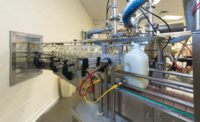Whey components can do all this: promote infant gut health, improve body composition, create novel foods and affect brain function. Scientists at the 6th International Whey Conference shared their research.
Sharon Gerdes, Contributing Writer
Milk is a complex biological food, which yields unique bioactive fractions that can be harvested via the whey stream. At the 6th International Whey Conference, Sept. 18-22 in Chicago, more than 425 attendees from 25 countries learned more about “The Power of Whey.” IWC 2011 was co-hosted by the American Dairy Products Institute, Elmhurst, Ill., and the European Whey Products Association, Belgium. Highlights of the conference included new information about how whey components can promote infant gut health, improve body composition, create novel foods and beverages and impact brain and cognitive functions.
BMO extraction
Human milk oligosaccharides are complex sugars present in breast milk that serve as prebiotics, or substrates for specific beneficial bacteria in the gastrointestinal system. Cow’s milk has a different concentration of these unique oligosaccharides than human milk. Identifying and extracting these bovine milk oligosaccharides (BMOs) from the whey stream has been the focus of several researchers, such as Daniela Barile and David Mills from the University of California Davis, Davis, Calif.
Mills is exploring the synbiotic relationship between prebiotic BMOs and probiotic bacteria to improve intestinal tract health. The presence of these beneficial bacteria can have long-term consequences for reducing intestinal pathogens, promoting neural development and decreasing the risk of developing allergies, asthma, eczema and autoimmune diseases.
Dairy foods, such as yogurt, are traditional delivery vehicles for probiotics, but face strong competition from dietary supplements. To compete against the supplement industry, the dairy industry needs to focus on milk’s distinctive healthy halo, as well as the unique structures and functions of BMOs and their synbiotic relationship to probiotics. Given the challenging regulatory environment for probiotics, speakers suggested that next generation efforts should concentrate on specific gut health targets and specific market segments, such as infants at high risk for allergenic diseases and individuals with irritable bowel syndrome.
Metabolic implications
Metabolic syndrome is a complex disorder that includes multiple markers such as insulin resistance, abdominal obesity, diabetes, dyslipidemia and hypertension. It affects one-third to one-half of the U.S. adult population, and is increasing globally. Several studies presented demonstrated the benefit of whey protein on metabolic health.
G. Harvey Anderson of University of Toronto noted that short-term studies with milk protein indicate an inverse association between dairy consumption and metabolic syndrome. His work showed that consumption of whey protein (55 grams) before a carbohydrate meal (30 grams) stimulated insulin secretion, slowed gastric emptying and reduced post-prandial glycemia in patients with type 2 diabetes. Further research by Margriet Westerterp-Plantenga of Maastricht University in the Netherlands found that at 10% of energy, whey decreased hunger more than casein or soy.
While obesity is a concern for many in the United States and other countries, under-nutrition affects 830 million people in the developing world, whereas severe acute malnutrition affects 195 million children. The incremental use of dairy ingredients, such as 3% of whey protein concentrate 80 in ready-to-use nutritional foods like Plumpy’nut, shows promise to combat malnutrition in vulnerable populations.
Consumption of whey protein can also have a positive effect on muscle synthesis, but there are distinct differences in protein utilization by younger active adults and the elderly.
“Carbohydrate and protein supplementation post exercise can enhance the rate of recovery and improve subsequent exercise performance by increasing rehydration, glycogen storage and reducing muscle damage,” says John Ivy of the University of Texas, Austin, Texas. In a 9-month study with active adults, Brian Kupchak of the University of Connecticut, Storrs, Conn., found that resistance training with whey protein supplementation was superior to soy protein for elevation of fat-free mass.
Sarcopenia, which literally means “poverty of flesh,” is an age-associated decline in skeletal muscle mass. Stuart Phillips of McMaster University, Hamilton, Ontario, explained that 20 grams of whey protein optimally stimulated muscle protein synthesis in young men, while up to 40 grams was required for optimal stimulation of MPS in older men.
Improving whey flavor and functionality
The dairy industry continues to develop new process and novel ingredients from whey. New technologies presented included a biofraction isolation plant, which would produce unique ingredients enriched in lactoferrin, lactoperoxidase, immunoglobulins and/or whey growth factor extract. On the horizon are various non-thermal technologies, including high-pressure processing, high-power ultrasound, pulsed electric field and microfluidization, which can preserve bioactive fractions of whey. Ongoing work is exploring whether complexing dextran with protein will enhance functionality, and at the same time mask the IgE binding sites of the protein, potentially decreasing food protein allergenicity.
A variety of whey protein aggregates with various structures and physicochemical properties can be produced by controlling pH and adding salts. This technology could produce whey protein with optimal foam stabilization in dairy beverages. Various methods to restrict protein denaturation by providing steric hindrance and manipulating protein charge were presented. These offer promise to improve heat stability of whey proteins. The impact of various whey processing steps on the flavor and aroma of whey proteins and various strategies to further enhance the quality of whey ingredients was also explored.
Methods for fractioning whey into specific bioactive proteins using a cascade of anion and cation exchanger membranes have been performed at lab scale and are ready for scale up at the pilot plant scale. Microparticulation of fractions of α-lactalbumin and β-lactoglobulin shows unique functional properties that could improve texture in yogurt and reduce meltdown in ice cream. Special non-gelling whey proteins show potential to improve texture and shelf life in bars and to improve texture and flavor in yogurt.
Regulatory updates
Conference presenters explored the regulatory climate from both European and U.S. perspectives. In Europe, the European Food Safety Authority (EFSA) has broad powers to control nutrition claims, not only on food labels, but also at point-of-sale materials, in brand names and on websites. Recently, EFSA approved a number of protein claims, but these claims are allowed for all protein ingredients, regardless of protein quality. In the United States, there is greater room for structure-function claims, as long as the food manufacturer has adequate substantiation for the science behind the claim. The Dairy Research Institute, Rosemont, Ill., developed a number of resources to help food companies navigate the regulatory environment.
Future needs and opportunities
Conference attendees also learned of the potential of whey to move into new arenas as functional and nutritional ingredients. One area that is being explored is the formation of whey fibrils, which are unique filamentous structures with potential to enhance viscosity at low concentrations. Their unique amyloid-like structure warrants exploration in biomedical applications, including the study of Alzheimers and Parkinson’s disease.
The next International Whey Conference will be held in Europe in 2014.
Sharon Gerdes writes Dairy Foods' Dairy Detective column. She is a food industry consultant who works with the U.S. Manufacturing & Ingredient Marketing program at the U.S. Dairy Export Council.
Get our new eMagazine delivered to your inbox every month.
Stay in the know on the latest dairy industry trends.
SUBSCRIBE TODAYCopyright ©2024. All Rights Reserved BNP Media.
Design, CMS, Hosting & Web Development :: ePublishing


